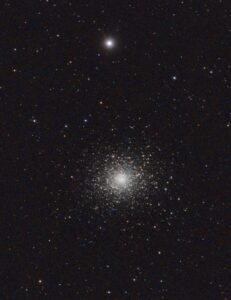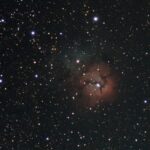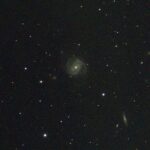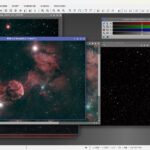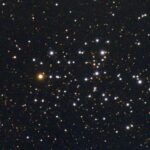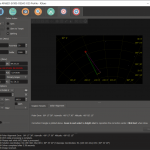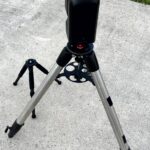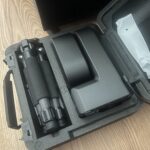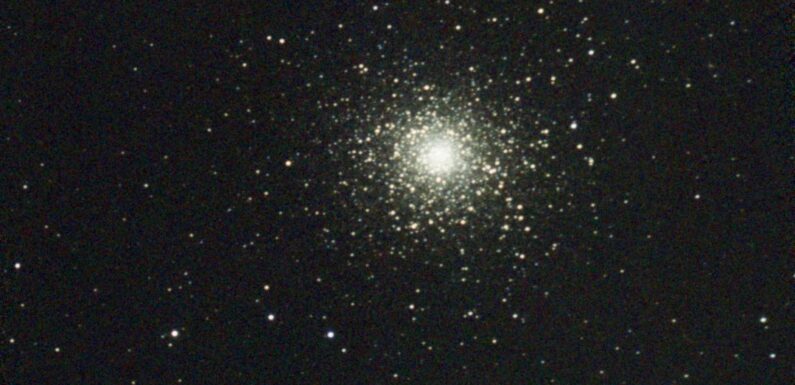
Been a bit since we have had a clear sky here in Southeastern Virginia. The last time I had the opportunity to collect some light was on Mother’s Day. The forecast for Tuesday night looked decent so I set up the SeeStar S50 in the drive way. I started this EAA session even before the sky was good and dark, and still the SeeStar did not disappoint giving me some great views of Messier 13 to start out. I didn’t really have a plan for the night, just looking to see what I could see. After M 13 I bounced around a few other globular clusters. Ended up spending a couple hours observing.
I put the SeeStar on the mount around 8:30 PM, the sky was still pretty bright. A firmware update was waiting for me, but that only took a couple minutes. Once the firmware update was complete I checked and adjusted the level, then waited for it to get a bit darker. I started taking my first images just after 9 PM. Through out the session the sky was nice and clear with temperatures in the mid-70s, there was a fair bit of humidity but I did not have any issues with dew.
The images from this EAA session were captured using the SeeStar S50 set up on a CG5 tripod. Live stack integrations are around 15 minutes with no post processing or enhancements performed on the captured images outside of the live stack. The images were saved just as they were observed on iPad screen in the SeeStar app.
Globular clusters, also knows as globulars or sometimes globs, are conglomerations of stars which can contain many thousands to many millions of stars all bound together by gravity. Globulars tend to be older, denser, and composed of lower abundances of heavy elements than open clusters. There are more than 150 known globular clusters in the Milky Way Galaxy. As you can see in the following captures these globular star clusters are great targets for the SeeStar S50 smart telescope.
Messier 13 (M 13), the Great Hercules Cluster, a globular cluster in the constellation of Hercules. SeeStar live stack of 90 x 10 second exposures, IR CUT filter. This capture was before astronomical twilight so sky was not yet completely dark.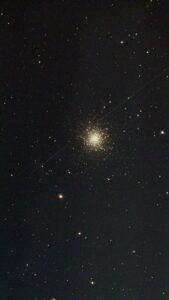 There are several hundred thousand stars in this globular cluster which is about 25,000 light-years from Earth. Had a satellite buzz through the field of view near the end of the live stack.
There are several hundred thousand stars in this globular cluster which is about 25,000 light-years from Earth. Had a satellite buzz through the field of view near the end of the live stack.
Messier (M 3) a globular cluster in the constellation of Canes Venatici. SeeStar live stack of 90 x 10 second exposures, IR CUT filter.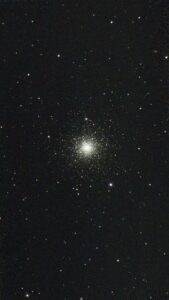 M 3 is around 32,000 light-years from Earth and is made up of around 1/2 million stars. This globular cluster is estimated to be around 11.6 billion years old. There is a very small galaxy, NGC 5263, visible in the upper right of the FOV.
M 3 is around 32,000 light-years from Earth and is made up of around 1/2 million stars. This globular cluster is estimated to be around 11.6 billion years old. There is a very small galaxy, NGC 5263, visible in the upper right of the FOV.
Messier 12 (M 12) a globular cluster in the constellation of Ophiuchus. SeeStar live stack of 90 x 10 second exposures, IR CUT filter.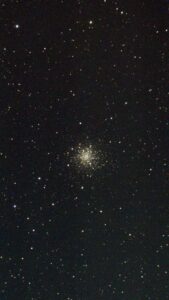 M 12 is approximately 16,400 light-years from Earth. Not quite as dense in the center as M 3 and M 13.
M 12 is approximately 16,400 light-years from Earth. Not quite as dense in the center as M 3 and M 13.
Messier 10 (M 10) is a globular cluster in the constellation of Ophiuchus. SeeStar live stack of 90 x 10 second exposures, IR CUT filter.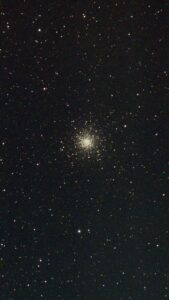 M 10 is 14,300 light-years away from Earth but it is only a few thousand light-years from M 12.
M 10 is 14,300 light-years away from Earth but it is only a few thousand light-years from M 12.
Messier 5 (M 5), the Rose Cluster, is a globular cluster in the constellation of Serpens. SeeStar live stack 91 x 10 second exposures, IR CUT filter.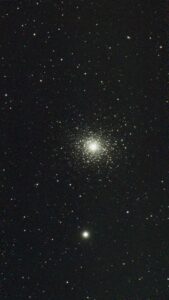 M 5 is about 24,500 light-years from Earth. This globular was the last capture of the night and also my favorite from this session. I’ll probably run this one through Siril to see if I can bring out a bit more of the colors in the stars.
M 5 is about 24,500 light-years from Earth. This globular was the last capture of the night and also my favorite from this session. I’ll probably run this one through Siril to see if I can bring out a bit more of the colors in the stars.
Several other folks around southeastern VA were taking advantage of the clear skies… lot of chatter and some great images on the #looking-up Discord channel. I broadcasted my EAA session on Night Skies Network. There were not many folks on, so I was mostly talking to myself. I did have a nice chat with Mark from Yowah, Queensland Australia towards the end of the night.
Powered down and packed just after 11:10 PM. A fun EAA session using the SeeStar S50. I really dig this little gadget.
Did a bit of tinkering with the light collected from M5, my favorite from this session. I took the SeeStar FITS file from the live stack and did a bit of post-processing with GraXpert (Crop, AI Background Extraction and AI Denoise) and Siril (Remove Green Noise, Color Calibration, Deconvolution, Histogram Stretch, and Color Saturation). Looks pretty amazing. Pulled out some nice color in some of the stars.
